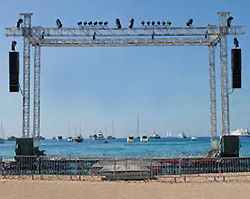
Greater Forces
It’s equally important to understand that an acute bridle angle places a considerable compression (or expansion) force on the object of mass, as a function of the angle of the bridle.
While this may be no problem for an industrial spreader beam that came at “no extra charge” with your recent 90-ton crane purchase, it often is a considerable problem when you suspend a loudspeaker, or loudspeaker array, using an acute bridle arrangement.
Many suspension frames are simply not designed or built to be loaded at sharp angles, and especially with far greater forces than the actual weight they were intended to support.
Not all frame designers and manufacturers are adept at imagining the full gamut of strange (and inappropriate) rigging arrangements that their frames may become subjected to.
If a loudspeaker uses simple eyebolts as a means of attachment (this is very common in small systems), even a shallow bridle angle will subject the eyebolts to forces they were not designed to accommodate.
Eyebolts – even the good ones – are intended primarily for a straight line-of-force load that aligns with their threads. (Figure 2) They should never be loaded laterally.

Though they can tolerate loading in the direction of their eye, as the angle decreases from a straight line of force, their load rating in turn decreases dramatically.
Other devices such as rigging frames, bumpers, etc, can exhibit similar limitations as eyebolts, but here the issues and properties are product specific.
One product may be able to tolerate an acute bridle, while another may not. It depends on the design geometry of the device being rigged, so there is no simple or single answer.
That said, the additional stress that’s put on the wire rope, the shackles, the Spansets and the other parts of the “hang” will all be magnified by using an acute bridle – even if the rigging frame or bumper itself can handle the load. Best idea: always use shallow bridles!
Rule of Life (this is like a “Rule of Thumb” but more so): do not bridle past a 30-degree angle (0 degrees being a straight line pull). See Figure 3. Doing so will place a significant compression force on the loudspeaker (or other object) that you’re intending to suspend.
Situations may arise in which you must bridle tighter than 30 degrees. In such case, the shackles should be oriented towards the line-of-force so that they pivot easily towards the load point. If there are eyebolts in the rig, they will need to become expensive swivel eyes, rather than inexpensive static eyebolts.
With sharp bridle angles, considerable care must be exercised to insure that no parts are overloaded.

